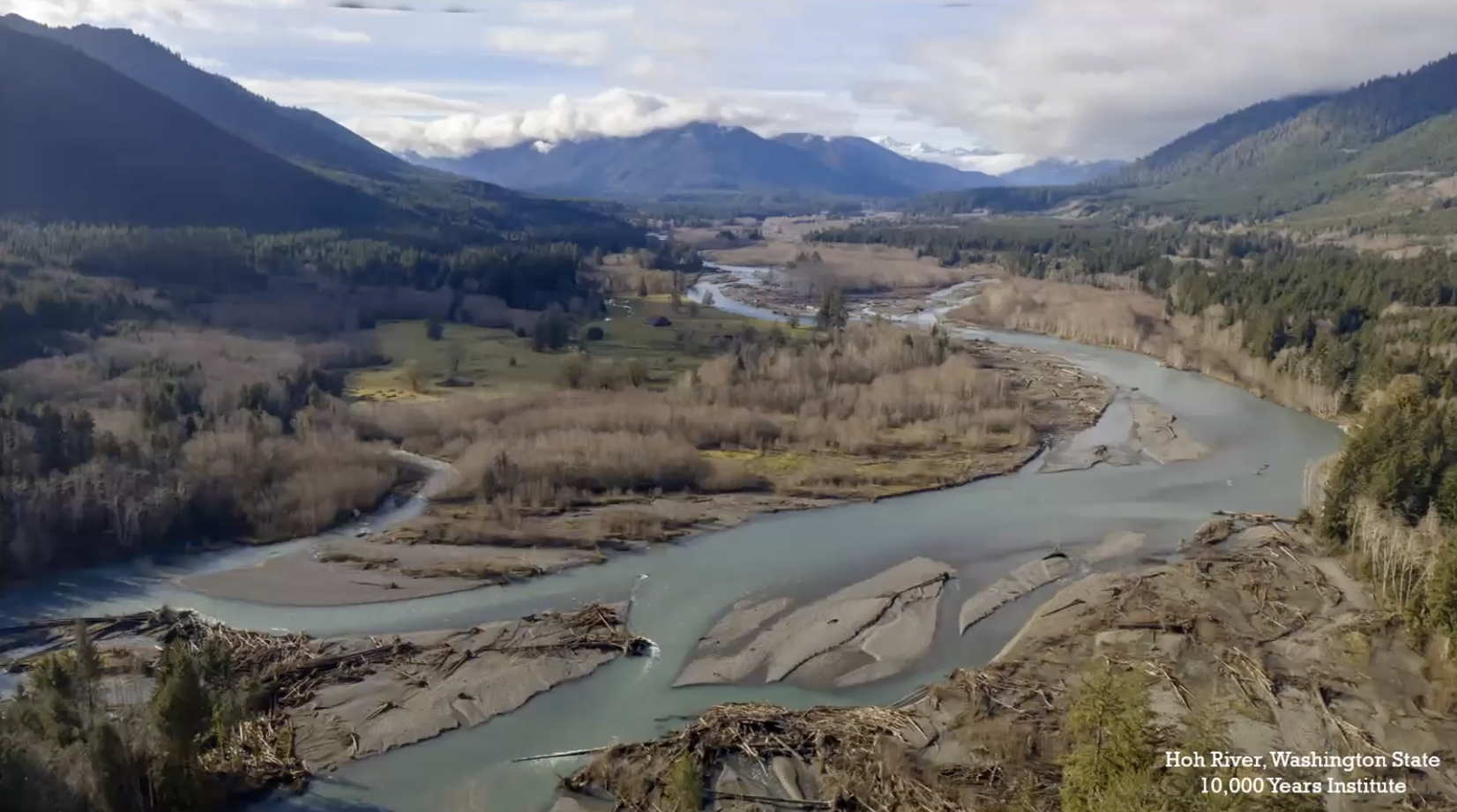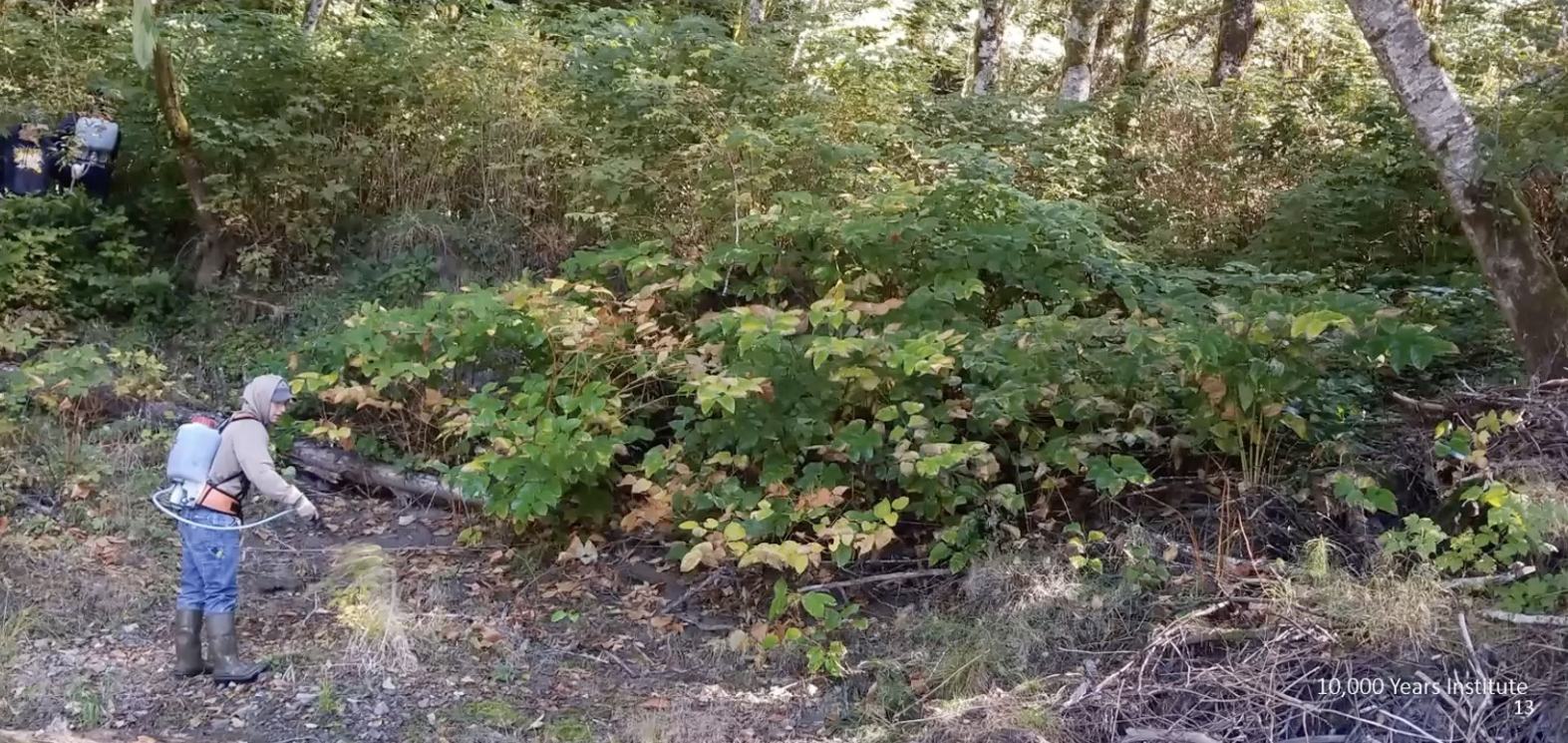Chasing Knotweed on One River: 20 Years of Lessons Learned

In popular culture, the fog-shrouded community of Forks, Washington is known for its Sasquatch sightings and as the small town where Bella Swan met her vampire (and later, werewolf) boyfriends in the Twilight books. Local souvenir shops cater to both interests.
In real life, the small town in Washington’s Olympic Peninsula sits nestled in a unique, biologically rich region in North America’s only temperate rainforest. Nearby rivers, fed by melting glaciers high in the Olympic mountains, are home to five species of wild salmon and hundreds of other species of native fish, amphibians, wildlife, birds and invertebrates.
And, like too many other landscapes in too many other places, the region is threatened by non-native, invasive plants that can fundamentally alter the ecosystem at the expense of the region’s native plants and animals.
Knotweed is one of those invaders. A member of the buckwheat family, knotweed was once planted as an ornamental before becoming recognized as a dangerous invasive that forms dense monoculture stands that shade and crowd out native species and change streamside ecosystems.
And on the Hoh River near Forks, knotweed planted at a homestead in the early 1900s was swept downstream when the river shifted sometime around the year 2000.
“Three years later, I found it dotted on gravel bars dotted down the river,” said Jill Silver, now executive director of the 10,000 Years Institute, a Forks-based non-profit focused on ecological restoration and sustainability. “We have been chasing that one clump from the homestead ever since, all the way to the mouth, 30 miles downriver.”
For Silver, that introduction began a two-decade-and-counting battle against the invasive plant – as well as several others – and led to the creation of a unique dataset that may help uninvaded rivers avoid the same fate.
As for the Hoh, though, the struggle continues and the outcome is unclear.
Why Invasive Species Matter
While knotweed was the first invasive species that prompted concerted eradication efforts on the Hoh, several other invasive species are now also targeted, including reed canary grass, herb-Robert, Scotch broom, Canada thistle and tansy ragwort. All pose a threat to native landscapes.
“The reason they're a problem,” Silver explained, “is because they replace native plants with a species that isn't eaten by or lived in or develops soil like all the native species that they replace. They form monocultures and are extremely aggressive, typically grow deep and wide, have thousands of seeds and the seeds last a long time.”
But with knotweed, seeds aren’t the problem. The plant produces extensive root systems and can propagate from root fragments, and the Hoh River is undammed and dynamic and constantly evolving and eroding new channels and banks.
It keeps Silver awake some nights.
“We know every time we miss a plant it might be scoured out by river-channel changes and torn apart and chewed up and floated out and dropped elsewhere and reburied or it could just root sitting in water,” she said. “We know we’ll have the start of another invasion down the river.”
Eventually, the rhizomes that allow the plant to regrow will be exhausted, but no one knows when that might happen or even how they’d know when it did. So the 10,000 Years Institute seeks new funding every two years to hire crews to survey and treat knotweed and 25 other non-native species on the Hoh River and nearby watersheds.

Sharing the Science
In the 20-plus years of work, the Institute’s crews have developed best management practices for treating each of the targeted species, and they’ve also geolocated every knotweed sighting. That data – combined with ongoing mapping of the river’s changes – led to a 2022 Western IPM Center-funded project to analyze that data and correlate river features with knotweed discoveries.
Lauren Kuehne from Omnifishient Consulting did the data analysis.
“So we have a completely unconstrained, unregulated river, which makes it interesting scientifically because we're actually able to study the dynamics and the relationships of invasive-plant establishment and persistence in relation to features like flow, channel width, substrate, bank stability, these kinds of things,” Kuehne explained.
The utility of understanding those correlations are twofold. First, in a river with a knotweed invasion, the models can help land managers identify areas where knotweed is most likely to establish and prioritize those areas for surveys and treatment. The second potential use of the data is to predict the likelihood of establishment and persistence in an uninvaded river.
The biggest impact the data has had so far, though, is as a cautionary tale.
“When you look at a map of where knotweed started and where it was just three years later, the spread, and prevalence very far down the river was astonishing. It's highly instructive,” Kuehne said. “I think those management stories can be helpful because weed management coordinators can sometimes struggle to communicate the level of risk and the costs that it's going to take if invasive species get into their river.”
Visualizing an Ideal Future
With a name like the 10,000 Years Institute and a focus of natural habitat preservation and restoration in geological-scale timeframes, it’s no surprise that Silver finds two-year funding cycles short sighted.
Instead, she’s proposing permanent funding for crews of 10 people per watershed to work year-around, targeting each species when it’s most treatable. The crews would get training and engage experts in engineering, road construction, heavy equipment operations, boat operations, forestry and related industries. They’d participate in natural resources programs at the local colleges, and there would be housing available for them and their families.
It's a paradigm shift.
“We have the Washington Conservation Corps and the AmeriCorps model and those are great except they are term limited,” Silver said. “They are not place-based except for the term. We’d like to see people develop the skill sets to do this kind of work and then keep folks working where they live, where their families live, augmenting the natural resources industries like timber and fish and recreation that rely on healthy forests and healthy rivers.”
Silver’s experience and Kuehne’s data analysis both support a long-term approach.
“What we can see in these data – we can measure it, we can quantify it, we can communicate it – is that multidecadal commitments are required in order to respond to invasive plants,” Kuehne said. “You can control and remove plants and make a substantial impact, but it's going to take time.”
And it takes ongoing detection and rapid response efforts.
“It's not difficult to imagine what will happen if you stop treating a plant like knotweed,” she said. “It will rebound and start to spread again. Maybe it would take five to 10 years, but it will be just as prevalent again as it was.”